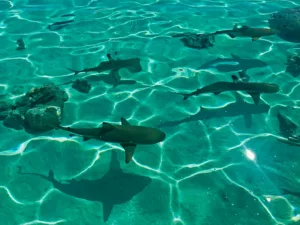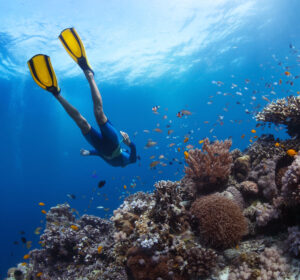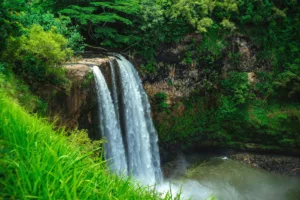Hawaii, with its vast Pacific waters, offers a unique opportunity for whale enthusiasts to witness some of the most magnificent marine creatures in the world. In this blog post, we will delve into the various types of whales that inhabit the waters around Hawaii, providing a comprehensive guide for those eager to catch a glimpse of these majestic creatures.
Humpback Whales
One of the most iconic whale species found in Hawaiian waters is the humpback whale (Megaptera novaeangliae). These massive creatures, known for their distinct humped backs and long pectoral fins, migrate to Hawaii during the winter months, making it an ideal time for whale watching.
Humpback whales are renowned for their acrobatic displays, including breaching, tail slapping, and fin waving. Visitors can often spot them near the islands of Maui, Kauai, and the Big Island.
Orcas, or Killer Whales
While not as common as humpback whales, orcas (Orcinus orca) can occasionally be spotted in Hawaiian waters. Known for their intelligence and striking black and white markings, orcas are formidable predators.
They prey on fish, squid, and marine mammals, making the waters around Hawaii an attractive feeding ground. Lucky whale watchers may witness the impressive sight of orcas hunting or playing in the open ocean.
Pilot Whales
Another intriguing whale species found in Hawaii is the pilot whale. Two distinct species inhabit these waters: the short-finned pilot whale (Globicephala macrorhynchus) and the long-finned pilot whale (Globicephala melas). These social and tight-knit groups of whales are often seen swimming gracefully in the Hawaiian seas.
Their distinctive bulbous heads and sleek bodies make them easily identifiable, and they are known for their friendly interactions with boats.
Sperm Whales
For those seeking encounters with the largest toothed whales, Hawaii provides opportunities to spot sperm whales (Physeter macrocephalus). These deep-sea divers are recognized by their massive heads, which house the largest brains in the animal kingdom.
Sperm whales are often seen near the Kona coast of the Big Island, where the deep underwater canyons create a suitable environment for their hunting activities.
Minke Whales
Minke whales (Balaenoptera acutorostrata) are the smallest of the baleen whales and can also be found in the waters around Hawaii. Although they lack the sheer size of humpback whales, minke whales are agile swimmers and can display acrobatic behaviors.
Whale watchers may spot them feeding near the surface, making for captivating observations of their streamlined bodies and distinctive dorsal fins.
Beaked Whales
The deep waters around Hawaii are also home to various species of beaked whales, including the Blainville’s beaked whale (Mesoplodon densirostris) and the Cuvier’s beaked whale (Ziphius cavirostris). These elusive creatures are known for their extended, dolphin-like beaks and prefer deep-sea environments.
While sightings of beaked whales are less common, their presence adds to the diverse marine life that calls Hawaiian waters home.
Whale Conservation In Hawaii
As we marvel at the awe-inspiring beauty of whales in the waters around Hawaii, it becomes imperative to address the crucial issue of whale conservation. Hawaii is not only a sought-after destination for whale watchers but also serves as a critical habitat
for various whale species, contributing to the delicate balance of the marine ecosystem.
Understanding and supporting whale conservation efforts is essential to ensure the continued well-being of these magnificent creatures.
Marine Protected Areas
Hawaii has established Marine Protected Areas (MPAs) to safeguard crucial habitats for whales. These areas provide a sanctuary where marine life can thrive undisturbed. Highlight the significance of these zones in preserving the feeding and breeding grounds of whales, fostering a deeper appreciation for the interconnectedness of marine ecosystems.
Research and Monitoring
Ongoing research and monitoring initiatives play a pivotal role in understanding the behaviors, migration patterns, and health of whale populations. By supporting scientific endeavors in Hawaii, we contribute to a broader understanding of these marine giants, enabling more effective conservation strategies.
Collaboration with Local Communities
Successful whale conservation in Hawaii involves collaboration with local communities. Engage readers by exploring how community-based efforts, educational programs, and outreach initiatives contribute to the protection of whales. Emphasize the importance of sustainable tourism practices that minimize disturbances to these marine habitats.
Conservation Challenges
Acknowledge the challenges facing whale conservation in Hawaii, such as climate change, ocean pollution, and potential disturbances from human activities. Shed light on the collective responsibility to address these challenges and emphasize the role individuals can play in minimizing their ecological footprint.
Partnerships with Conservation Organizations:
Showcase partnerships between Hawaii and conservation organizations dedicated to marine protection. Highlight specific projects and initiatives aimed at preserving the habitats and ensuring the survival of whale populations. Encourage readers to support and contribute to these organizations actively.
Come to Hawaii and see Whales!
The waters surrounding Hawaii offer a rich tapestry of whale species, providing an unparalleled opportunity for enthusiasts and nature lovers alike. From the iconic humpback whales to the elusive beaked whales, each species contributes to the unique marine ecosystem of the Pacific.
Whale watching in Hawaii not only offers a chance to witness these incredible creatures in their natural habitat but also supports conservation efforts to protect and preserve their existence for future generations.
So, whether you’re a seasoned whale watcher or a first-time visitor, exploring the types of whales in Hawaii promises a truly unforgettable experience.
For any additional questions or concerns, contact Ocean Outfitters at (808) 400-5931, your premier water adventures provider in Haleiwa, Hawaii.



